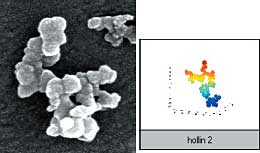 |
||
| Massachusetts Institute of Technology |
|
Integrated Program on Molina Center for Energy and the Environment Voice: (858) 657 Fax: (858) 657- E-mail: info@mce2.org |
Impact of soot on cloud formationRosario Guzman, Gustavo Sosa, and Abel ToribioWhy are we paying attention to the properties of soot that involve water? This question sounds trivial: health and visibility problems related to high concentration of soot are familiar enough. However, there is a process associated with soot’s geometry that has defied our intuition. Soot is a black carbonaceous substance produced during incomplete combustion of coal, wood, oil, etc., rising in fine particles that adhere to and blacken surfaces on contact. It is hydrophobic (that is, it does not absorb water). In fact, the soot-water contact angle is around 80°. Contact angle measures “how much a substance wets a surface,” thus a small contact angle reflects hydrophilic (strong affinity for water) surfaces, while a large contact angle indicates a hydrophobic surface.
Until recently, soot was modeled as a sphere having properties equivalent to those of the real particle. This model con- firmed our intuitive idea with respect to the amount of water able to condense on soot’s surface: it was insignificant, and increasing this amount required extremely supersaturated air. Let us not forget though that these conclusions depend strongly on the model used, and that soot is far from having a spherical contour. In 1996, Xie and Marlow from Texas A&M University investigated the effect of substrate surface curvature on water equilibrium vapor pressure. Figuring out what they called “complex aerosols” (two to four identical spheres stuck together, fixed in ten different configurations), they determined the water volume content as a function of relative humidity. In order to do this, they used “Surface Evolver,” a free access program available in the Internet. Evolver is a program that minimizes the energy of a system subject to forces and restrictions specified by the user. In this way, Xie and Marlow determined the equilibrium thermodynamic conditions for an air-water-substrate system subject to waterair surface tension. The results revealed strong sensitivity of vapor pressure with regards to surface geometry; one of the more relevant results can be understood as soot able to absorb limitless water amounts. In 1979, Forrest and Wien noticed the fractal nature of several aerosol particles such as metals, metal oxides, silicon dioxide and soot, which are formed by aggregation of small, nearby spherical particles (that we will call “primary particles”). A fractal is a mathematical concept that “qualitatively can be described as a rough object such that its roughness appears at any scale” (Jullien and Botet, 1987). This quality can be accounted for by a quantity called fractal dimension, “which do not have any reason to be an integer” (contrary to the dimension of a smooth curve or surface, Figures 1 and 2 respectively). Although perfect fractals do not exist in nature, irregular fractal-like shapes do. Such is the case of fractured surfaces, ecological systems, cloud profiles, “the intricate arrangement of flying-bird-wing feathers” (Stoyan and Stoyan, 1994), and fresh soot. This last has a fractal dimension between 1.7 and 1.9. In 1996, Thouy and Jullien proposed an algorithm to generate fractals of fractal dimension between 1 and 2.55, and an arbitrary number of primary particles. In nature, particles stick together in different ways, such as one particle to another, a particle to an aggregate, or an aggregate to another aggregate. Thouy and Jullien used the aggregate-aggregate mechanism as it beer reflects soot’s aggregation processes.
In 2002, Toribio and Guzman developed an aerosol simulation system based on Thouy and Jullien’s algorithm. Once this simulation system was available, Sosa (2002) and Guzman et al. (2002) investigated if Xie’s aerosols appear in “real” fractal- like soot aerosol particles and if they do, how frequent they are. The answer was “yes, several of those 10 geometrical configurations are present.” As some may know, cloud condensation nuclei (CCN) must be available in the atmosphere for clouds to grow. Traditionally, CCN were considered to be hydrophilic particles. Nevertheless, aer their findings, Guzman et al. predict that soot is able to become CCN, and they provide an estimated value for the relative humidity necessary. Therefore, we come to important conclusions: thanks to its roughness, soot absorbs more water than we thought; moreover, it has the capability to form clouds under conditions commonly encountered in the atmosphere. (Geometrical properties “against” physical properties). What properties do these “new” clouds possess? What effect do they have on Earth’s energy budget? If soot absorbs water, it probably absorbs other substances too. Does this property affect people’s health? Does it influence particle chemistry? These and other questions are being investigated as part of the MIT-CAM Project. AcknowledgementThis work is supported by the Integrated Program on Urban, Regional, and Global Air Pollution with funds from the Comisión Ambiental Metropolitana. References
R. Guzmán, A. Toribio, Escuela Superior
de Ingeniería Química e Industrias Extractivas del
IPN; G. Sosa, Programa de Investigación en Medio Ambiente
y Seguridad, Instituto Mexicano del Petróleo. |


